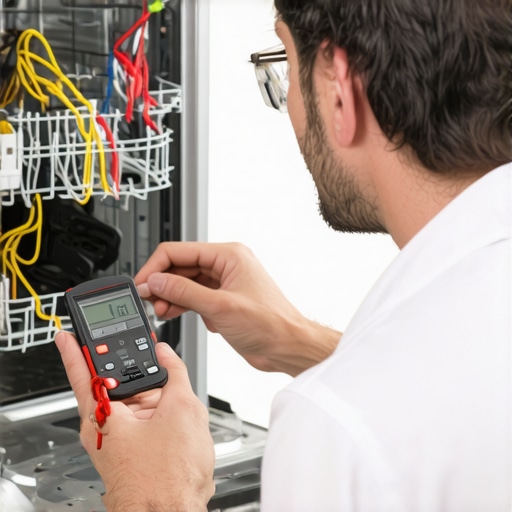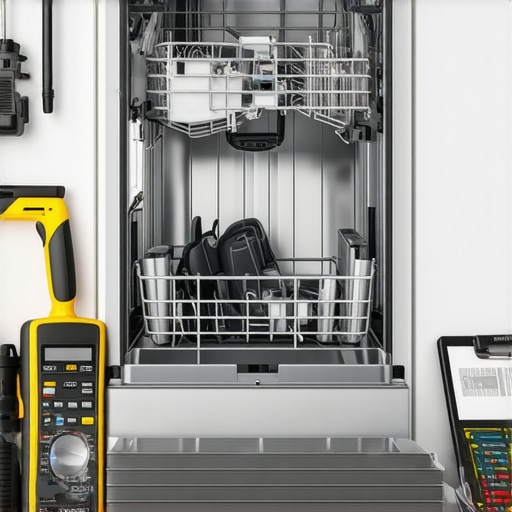My First Dishwasher Woes and the Quest for Quick Fixes
I’ll never forget the day my dishwasher decided to act up just before a dinner party. Frustration kicked in, but I realized that understanding some basic diagnostic tips could save the day. Personal experience has shown me that a little troubleshooting goes a long way in resolving common dishwasher issues swiftly.
Why Knowing the Basics Can Save Your Kitchen Day
Over time, I’ve learned that familiarizing myself with simple diagnostic techniques can turn a potential disaster into a manageable repair. For example, understanding how to check the water inlet valve or the drain pump can help identify the root cause without calling a professional immediately. This approach not only saves money but also empowers me to handle unexpected breakdowns confidently.
Key Diagnostic Tips I Always Keep in Mind
One tip I swear by is inspecting the dishwasher’s filters regularly, as clogged filters often cause drainage problems. Additionally, testing the door latch ensures the machine operates safely and effectively. For more complex issues, consulting reputable sources like Top Appliance Diagnostic Tips has been a game-changer for me.
How Do You Know When to Call in the Pros?
Sometimes, despite my best efforts, problems persist. For instance, if the dishwasher isn’t heating water or making strange noises, it’s probably time to seek professional help. But knowing the typical signs can prevent unnecessary repairs and help you decide when expert intervention is genuinely needed.
What Are the Most Reliable Diagnostic Steps for a Dishwasher That Won’t Start?
When your dishwasher refuses to start, I recommend checking the power supply, door latch, and control panel. These are common culprits that can often be fixed with a simple reset or replacement of a faulty component. If you’re unsure, detailed guides like Expert Repair Tips can provide valuable insights.
If you’re interested in maximizing your appliance warranty, I suggest exploring these troubleshooting guides for comprehensive support.
Ultimately, I find that a proactive approach to dishwasher diagnostics not only extends the appliance’s lifespan but also boosts my confidence in handling household repairs. Feel free to share your own experiences or ask questions in the comments—I love exchanging tips and stories!
Are You Overlooking Critical Diagnostic Clues in Your Dishwasher?
As an experienced appliance technician, I’ve seen how small details can make or break a successful repair. Sometimes, a minor misstep in troubleshooting can lead to unnecessary replacements or overlooked issues. For instance, inspecting the wiring connections or testing the control board can reveal hidden problems that aren’t immediately obvious. When dealing with complex symptoms like inconsistent cleaning or persistent leaks, it’s essential to approach diagnostics methodically. For more comprehensive techniques, visit Top Appliance Diagnostic Tips.
What Are the Hidden Signs That Your Dishwasher Needs Professional Attention?
While some issues are straightforward, others whisper warnings that professionals recognize early. For example, a faint burning smell or unexplained electrical surges during operation could indicate wiring faults or component failures. Moreover, persistent error codes displayed on the control panel often point to specific malfunctions—understanding how to interpret these can save time and money. It’s crucial to know when a problem exceeds DIY scope; this knowledge stems from years of practical experience, ensuring you don’t compromise safety or damage the appliance further. To deepen your understanding, check out Expert Repair Tips.
How Can Advanced Diagnostics Improve Your Repair Accuracy?
Advanced diagnostics involve more than just basic checks; they include using multimeters to test electrical continuity, inspecting sensors, and analyzing error code patterns. These techniques help pinpoint root causes with precision, reducing guesswork. For example, if your dishwasher isn’t draining properly, beyond inspecting the drain filter, testing the drain pump motor’s electrical connections can reveal failures that simple cleaning won’t fix. Incorporating these meticulous steps enhances repair reliability and preserves your appliance warranty—by adhering to manufacturer diagnostic protocols, you ensure your repairs are recognized as professional. For detailed guidance, I recommend reviewing these troubleshooting guides.

Proper diagnostic tools and techniques are essential for accurate dishwasher repairs. Image shows technician testing electrical connections with a multimeter.
What Are the Practical Steps to Avoid Common Diagnostic Pitfalls?
Even seasoned technicians can fall into traps like misinterpreting error codes or overlooking simple issues such as tripped circuit breakers. To prevent these pitfalls, always verify the power supply first, then proceed systematically through components—checking the door latch, float switch, and wiring harness. Documenting each step helps in tracking the problem and avoiding unnecessary replacements. Remember, patience and a structured approach are your best allies. If you’re interested in honing your troubleshooting skills further, explore comprehensive diagnostic guides that combine theory with practical tips.
Beyond the Basics: The Nuances of Diagnosing Dishwasher Failures
As I delved deeper into the world of appliance repair, I realized that troubleshooting a dishwasher is much like peeling an onion—every layer reveals new complexities. For instance, when I encountered persistent drainage issues even after cleaning the filters, I learned to investigate the drain pump’s electrical connections, which often get overlooked. This level of diagnostic precision not only saves time but also minimizes unnecessary part replacements, a lesson I wish I had learned earlier.
How Do High-Tech Tools Elevate Your Diagnostic Accuracy?
Using tools like multimeters and circuit testers transformed my repair approach. For example, testing the electrical continuity of sensors or the control board with a multimeter uncovered hidden faults that simple visual inspections missed. According to Top Appliance Diagnostic Tips, integrating such advanced diagnostics enhances repair reliability. I’ve found that investing in these tools pays off by preventing misdiagnoses and ensuring lasting fixes.
What Are the Subtle Signs That Signal a Hidden Malfunction?
Sometimes, the clues aren’t obvious—like a slight, almost imperceptible electrical smell or intermittent error codes. I remember a case where my dishwasher kept showing a weird error code that initially seemed trivial. However, a more detailed diagnostic revealed a failing control board, which was causing erratic operation. Recognizing such subtle signs requires experience and a keen eye, and consulting authoritative sources can guide you through interpreting these complex symptoms.
How Can Mastering Diagnostic Protocols Save You Money and Hassle?
Adhering to structured diagnostic protocols ensures you target the root cause efficiently. For example, systematically testing the float switch, wiring harness, and control circuitry prevents unnecessary replacements. This disciplined approach, detailed in Expert Repair Tips, has helped me avoid costly mistakes and extend the lifespan of my appliances. Plus, it boosts confidence when tackling complex issues.
What’s the Role of Experience in Distinguishing Between Simple and Complex Problems?
Experience is invaluable—over time, I learned to differentiate between issues I could fix myself and those requiring professional intervention. For example, persistent leaks might be caused by worn door seals or cracked hoses, but electrical faults demand a more cautious approach. Recognizing when to escalate a repair not only safeguards safety but also preserves the integrity of the appliance. Sharing stories and learning from others’ experiences has been instrumental in sharpening my diagnostic instincts.
Final Reflections: Embracing the Challenge of Advanced Diagnostics
Engaging with complex diagnostics has transformed my repair mindset—from guesswork to precision. It’s a rewarding journey that continually deepens my understanding of how appliances function and fail. If you’re eager to elevate your diagnostic skills, I recommend exploring comprehensive guides like these troubleshooting resources. I’d love to hear about your experiences or insights—feel free to share in the comments or ask questions. Remember, mastering diagnostics not only saves you money but also empowers you to keep your household running smoothly, even in the face of unexpected appliance troubles.
Deciphering Complex Diagnostic Codes and Their Hidden Meanings
As I delved further into advanced troubleshooting, I realized that many dishwasher error codes are more than just superficial indicators—they’re encrypted messages revealing underlying issues. For example, a persistent F9 error often points to a problem with the water inlet or pressure sensor, but only a comprehensive diagnostic approach can confirm this. According to Top Appliance Diagnostic Tips, understanding the nuances of error code patterns and correlating them with sensor readings is crucial for accurate diagnosis. This level of expertise transforms troubleshooting from guesswork into precision, saving time and preventing unnecessary parts replacement.
How Do Multimeter and Sensor Testing Elevate Your Repair Accuracy?
Using multimeters to test electrical components is a game-changer. When I suspect a faulty pressure switch or a malfunctioning sensor, I don’t rely solely on visual inspection; instead, I meticulously measure resistance and voltage levels to verify their integrity. This detailed testing uncovers faults that can be easily overlooked, especially in complex control circuits. For instance, testing the drain pump motor’s wiring harness with a multimeter often reveals hidden issues that simple cleaning or replacement wouldn’t address. Integrating these advanced diagnostics aligns with manufacturer protocols, ensuring repairs are both reliable and compliant with warranty standards. For a comprehensive guide, explore expert repair tips.
Why Is Understanding the Control Board’s Role Critical in Complex Failures?
The control board acts as the appliance’s brain, orchestrating various functions. When a dishwasher exhibits erratic behavior—such as intermittent operation or unresponsive cycles—it’s often rooted in control board malfunctions. My experience has taught me that testing the control board’s circuitry with a multimeter and inspecting for burnt components or damaged connectors can reveal faults not evident during superficial checks. Recognizing subtle signs of control board failure, like flickering LED indicators or inconsistent error displays, demands a keen eye and technical know-how. According to research by industry experts, a failing control board can mimic multiple other issues, making precise testing essential for accurate diagnosis. For a deeper dive into these diagnostic strategies, visit these troubleshooting guides.
Can Advanced Diagnostics Prevent Costly Repairs and Extend Appliance Lifespan?
Absolutely. Investing in high-tech diagnostic tools like oscilloscopes or specialized sensor testers allows me to detect subtle electrical anomalies early on. This proactive approach prevents minor faults from escalating into major, costly repairs. For example, identifying a slow-developing short in the control wiring or a creeping voltage fluctuation can be pivotal. Incorporating these nuanced techniques aligns with manufacturer diagnostic procedures, ensuring the integrity of repairs and preserving your warranty. Moreover, leveraging detailed diagnostic data helps in making informed decisions—should you replace a part or attempt a repair? For comprehensive insights, I recommend reviewing these expert recommendations.
What Are the Best Practices for Systematic Troubleshooting in Complex Cases?
Deep experience has shown me that a structured diagnostic pathway is vital. Starting from verifying power supply and inspecting wiring integrity, then moving on to sensor and control circuit testing, ensures no step is overlooked. Documenting findings at each stage creates a diagnostic trail that prevents misdiagnosis and repetitive troubleshooting. When facing multifaceted issues like inconsistent cleaning or leaks, I rely on a comprehensive checklist rooted in advanced diagnostic principles. Engaging with authoritative sources and sharing insights with peers enhances my troubleshooting precision and keeps my skills sharp. For those looking to elevate their diagnostic game, I encourage exploring these expert techniques.
How Can Developing a Diagnostic Intuition Save Time and Money?
Over years of hands-on experience, I’ve cultivated an intuitive understanding of when to trust my diagnostics and when to seek professional help. Recognizing subtle clues—like a faint electrical hum or slight resistance variations—can be the difference between a quick fix and an unnecessary replacement. Developing this intuition involves continuous learning, analyzing failures, and understanding the intricate interplay of dishwasher components. Sharing my experiences and learning from industry benchmarks have been instrumental in honing this skill. If you’re eager to deepen your diagnostic expertise, I suggest immersing yourself in comprehensive guides like these resources. Embrace the challenge, and you’ll find that complex diagnostics become an engaging puzzle rather than a daunting task.
Things I Wish I Knew Earlier (or You Might Find Surprising)
The Power of a Systematic Approach
Early in my repair journey, I underestimated how critical a step-by-step diagnostic process is. Now, I realize that rushing to replace parts without thorough testing often leads to unnecessary expenses. Taking the time to verify each component, like the water inlet valve or drain pump, can save both time and money, making repairs more predictable and less stressful.
Sometimes Small Clues Reveal Big Problems
One lesson I learned the hard way was paying attention to tiny details, such as a faint burning smell or a slight delay in cycle completion. These subtle hints often point to underlying issues that aren’t immediately obvious. Trusting my intuition and investigating these clues has helped me avoid costly mistakes and catch problems early.
The Importance of Proper Tools
Having the right diagnostic tools, especially a good multimeter, transformed how I troubleshoot. Visual inspections are helpful, but electrical testing uncovers hidden faults in sensors or control boards that might look fine physically. Investing in quality tools has been a game-changer, and I highly recommend learning how to use them effectively.
Learning to Interpret Error Codes
At first, I found error codes confusing, but over time I discovered their true value. Understanding what each code signifies—like a faulty pressure switch or a clogged filter—helps target repairs more accurately. Exploring resources that decode these codes, such as Top Appliance Diagnostic Tips, can make a real difference.
Patience and Practice Are Key
Finally, I’ve learned that patience is essential. Diagnosing complex issues often requires multiple steps and careful observation. The more I practice, the better I become at recognizing patterns and subtle signs. It’s a skill that develops over time, and embracing this learning curve makes troubleshooting more rewarding.
Resources I’ve Come to Trust Over Time
- Top Appliance Diagnostic Tips: A comprehensive guide that breaks down diagnostic steps clearly. It’s been invaluable for understanding complex issues.
- Expert Repair Tips: Offers practical advice based on real-world experience, helping me avoid pitfalls and troubleshoot efficiently.
- Maximize Your Warranty Guides: Essential for understanding how to document repairs and ensure warranty compliance, giving me confidence in my DIY efforts.
Parting Thoughts from My Perspective
Diagnosing dishwasher issues might seem daunting at first, but with patience, proper tools, and a methodical approach, it becomes a manageable and even rewarding process. The key is to trust your observations, leverage trusted resources like those I’ve mentioned, and never underestimate the value of a good diagnostic routine. Over time, I’ve found that mastering these skills not only saves money but also empowers me to keep my appliances running smoothly. If this resonates with you, I’d love to hear your experiences or tips—share your story in the comments or ask questions. Remember, every problem has a solution, and sometimes all it takes is a little knowledge and perseverance to find it.

